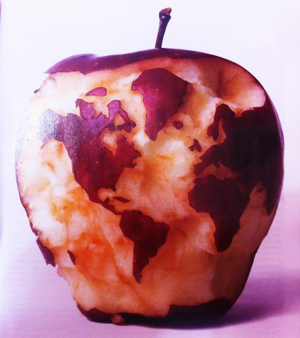
How aware are we of our food choices and their impact?
How are we going to deal with the food issues of the future?
What actions can we, as individuals, take to help? Or are the solutions limited to policy changes and technological developments?
I just read an interesting article in the November 2011 issue of Scientific American by Jonathan Foley called Can We Feed the World and Sustain the Planet?.
Foley, director of the Institute on the Environment at the University of Minnesota, highlights three major food issues facing humanity in the near future, as well as a five-point plan for addressing them.
Three Food Problems
1. End hunger.
Over a billion people go hungry. We should do something about that.
2. Double food production by 2050.
In order to deal with the increasing population, and the increasing wealth and living standards of that population, current food production will have to double by 2050.
3. Do (1) and (2) while drastically reducing agriculture’s damage to the environment.
We already use over 38% of the earth’s ice-free land for crops, pastures, and rangelands for lifestock. There is little room for expansion. There are fertilizer and pesticide runnoff problems. Water is a limited resource. Tropical forests are being cleared at an alarming rate. Etc. etc.
What can we do about it?
Five Solutions
A. Stop expanding agriculture’s footprint
Our first recommendation is to slow and ultimately stop the expansion of agriculture, particularly into tropical forests and savannas. The demise of these ecosystems has far-reaching impacts on the environment, especially through lost biodiversity and increased carbon dioxide emissions (from clearing land).
B. Boost productivity of low-yielding farms.
Since we want to stop the expansion of farmland, we must increase the productivity of already-existing farmland. There are lots of opportunities to do this.
C. Use water and fertilizers much more efficiently
Many farms throughout the world could use vast improvements in the efficiency of resource use.
D. Shift diets away from meat.
Feeding more people would be easier if all the food we grew went into human hands. But only 60 percent of the world’s crops are meant for people: mostly grains, followed by pulses (beans, lentils), oil plants, vegetables and fruits. Another 35 percent is used for animal feed, and the final 5 percent goes to biofuels and other industrial products. Meat is the biggest issue here. Even with the most efficient meat and dairy systems, feeding crops to animals reduces the world’s potential food supply. Typical grain-fed cattle operations use 30 kilograms of grain to make one kilogram of edible, boneless beef. Chicken and pork are more efficient, and grass-fed beef converts non-food material into protein. No matter how you slice it, though, grain-fed meat production systems are a drain on the global food supply.
…
Globally, humans could net up to three quadrillion additional calories every year – a 50 percent increase from our current supply – by switching to all-plant diets. Naturally, our current diets and uses of crops have many economic and social benefits, and our preferences are unlikely to change completely. Still, even small shifts in diet, say, from grain-fed beef to poultry, pork or pasture-fed beef, can pay off handsomely.
E. Reduce food waste.
Roughly 30 percent of food produced on the planet is discarded, lost, spoiled or consumed by pests.
…
Simple changes in our daily consumption patterns—reducing oversize portions, food thrown in garbage, an the number of takeout and restaurant meals—could significantly trim losses, as well as our expanding waistlines.
—
We can’t pick one of the solutions and focus solely on that. All five must be pursued. Foley uses the metaphor of a silver buckshot rather than a silver bullet.
As individuals we can’t address all of these issues or take part in all of the solutions. Some necessarily require government, policy, and industry changes, which are hard to directly influence.
We can, however, clearly do something about D and E by reducing our meat consumption and our waste.
This type of stuff is one of the main reasons why I became a 99.9% vegetarian.
How about you? Does this article make you think about your food choices? Are you willing to change any of them?
Read a snipped of the article and see some of the maps here.
Photo from the Scientific American article.
///


